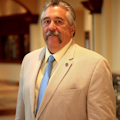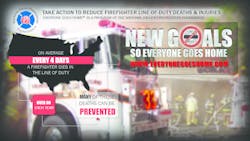NFFF New Goals Campaign: Who Responds to a Firefighter’s Worst Day?
We come into your home on the worst day of your life. We are trained firefighters. We’re ready to respond. We’re calm and professional. Some might say we’re unflappable in the face of danger. But what’s going on inside our heads when the emergency is over? We’re human, too.
Sometimes what we witness during a call hits too close to home or the pressures of life outside the firehouse seem insurmountable. Before we know it, the walls we’ve established to protect ourselves emotionally begin to crack. We’re often the last to notice. But if they aren’t shored up, those walls might come crashing down.
The Personal Side of Public Safety
We are all different. It can be hard for us to understand what’s going on with another firefighter who has responded to the same calls we have. A seemingly routine response for one firefighter may be the final trigger that unleashes bottled up pain in another.
Like many of you, I’ve listened to firefighters and their families dealing with pressures in their lives, but had no idea how serious the issues really were. Firefighters are dealing with problems inside and outside the fire department that can impact their performance and mental well-being. Do any of these sound familiar?
- Another call to extricate the bodies of teens from a horrific crash leaves you too worried about your own kids to focus.
- A house fire was caused by a senior citizen leaving food on the stove, something your Mom has done repeatedly.
- Bills are unpaid and creditors are calling because you’ve been laid-off from your full-time job for months with no prospects in sight.
- The time to permanently hang up the helmet is getting closer and you don’t know how you’ll fill the void.
Undoubtedly, the path we’ve chosen is physically and psychologically filled with extreme highs and lows. Forbes Magazine rated firefighter as the most stressful job of 2015 http://www.forbes.com/sites/susanadams/2015/01/07/the-most-stressful-jobs-of-2015/. Firefighting is consistently rated in the top three most stressful jobs by organizations such as CareerCast http://www.businessnewsdaily.com/5744-most-and-least-stressful-jobs-for-2014.html.
Dr. Richard Gist, principal assistant to the director of the Kansas City (MO) Fire Department and National Fallen Firefighters Foundation (NFFF) behavioral health consultant observes: Every day firefighters have the same experiences as everyone else and they see what goes on in everyone else’s life. They do the work in dealing with the problems of living. Firefighters still have personal lives and personal lives have issues.
A new priority: Taking care of ourselves and each other through Initiative 13
Research studies and lessons learned from multiple line-of-duty death incidents such as September 11 (343), Charleston, SC (9), West, TX (10) and Yarnell, AZ (19) showed us something very important: No two firefighters will have the same reaction to the same stressful incident.
We also learned that a fire department is now three times more likely to experience a suicide than a line-of-duty death. There is no doubt the fire service is facing a national suicide problem.
Two years ago, the NFFF began to improve the way the fire service helps firefighters manage stress by developing the Firefighter Consensus Behavioral Health Model.
The Behavioral Health Model reinforces that there are varying stress thresholds that need to be considered when offering assistance following a traumatic event. It tells us that a person’s experiences, values and beliefs can impact how they react to any call.
Issues a person is contending with outside the firehouse can impact their ability to manage the stressful events in the firehouse. This is one reason why what a firefighter sees, hears or touches may affect him or her, but may be the tipping point for their crew mate.
Initiative #13 of the Firefighter Life Safety Initiatives is the foundation for our work. Its message is very clear: Firefighters and their families must have access to counseling and psychological support.
Discussions during Tampa2 and other related meetings focused on how the fire service can help reduce the stigma often attached to seeking help. We must look-out for and respond to calls for help from within our ranks just as we do for the public.
One of the easiest ways to assess how someone is coping is through the After Action Review (AAR). Talking after every call about what went well and what needs to be improved helps us refine our strategies and tactics. It also enables the officer to get a pulse on the emotional health of the team.
These casual conversations can help improve trust within the crew, which is critical for improving emergency operations for the next call. They can also be the key for recognizing when someone needs to talk or to get outside help.
Peer support groups, such as those offered by the FDNY Counseling Unit, have found that firefighters are more comfortable talking with each other in a casual setting about concerns and issues they’re facing. It’s much easier to turn to someone you know and who understands your experiences.
The NFFF offers two classes on dealing with stress – Curbside Manner: Stress First Aid for the Street (CMSFAS) and Stress First Aid for Fire and EMS Personnel (SFA) – for free through www.FireHeroLearningNetwork.com.
CMSFAS is built upon seven components or the “Seven C’s”:
- Check: Pay attention to others’ behaviors and attitudes. Ask questions and carefully listen to the answers. If something seems unusual or “off” from a person’s normal routine, move to the next step.
- Coordinate: Share what you’ve observed with a friend, colleague or family member.
- Cover: Promote a sense of safety.
- Calm: Reduce stress, provide comfort and orient those who are distressed.
- Connect: Reconnect or link individuals with family, friends or other sources of support.
- Competence: Provide a link to resources they may need.
- Confidence: Help those affected regain a sense of hope and confidence in themselves.
The ‘Seven C’s’ help firefighters take care of themselves and one another. They also can lead to one-on-one or group interventions. These interventions can ensure safety, reduce the risk for more severe stress reactions and help to promote recovery for firefighters and families in need.
I encourage you to look at the Behavioral Health Initiative #13 on our website at http://flsi13.everyonegoeshome.com/ for more information about this important issue in the fire service. Working together we can reduce the number of suicides and stress in the fire service. We must all help our fellow firefighters and our fire service families receive the support they need when they need it.
About the Author

Ronald Siarnicki
National Fallen Firefighters Foundation
Fire Chief Ronald Jon Siarnicki began his career as a firefighter with the Prince George's County Fire/EMS Department in 1978 and with 24 years of fire, rescue, and emergency medical services operational experience, he has progressed through the ranks to Chief of the Department. In this position he served as the Chief Executive Officer responsible for the fire, rescue and emergency medical services of Prince George's County, Maryland. In July of 2001, Chief Siarnicki retired from the Prince George?s County Fire/EMS Department to take the position of Executive Director of the National Fallen Firefighters Foundation in July of 2001. He is a graduate of the Masters Program, School of Management and Technology, at the University of Maryland, University College, College Park, Maryland and has a Bachelor of Science Degree in Fire Science Management from UMUC. He is a certified Fire Officer IV, Fire Fighter Level III, and State Emergency Medical Technician. He has served as a UMUC faculty member for the Fire Science Curriculum since 1997.
